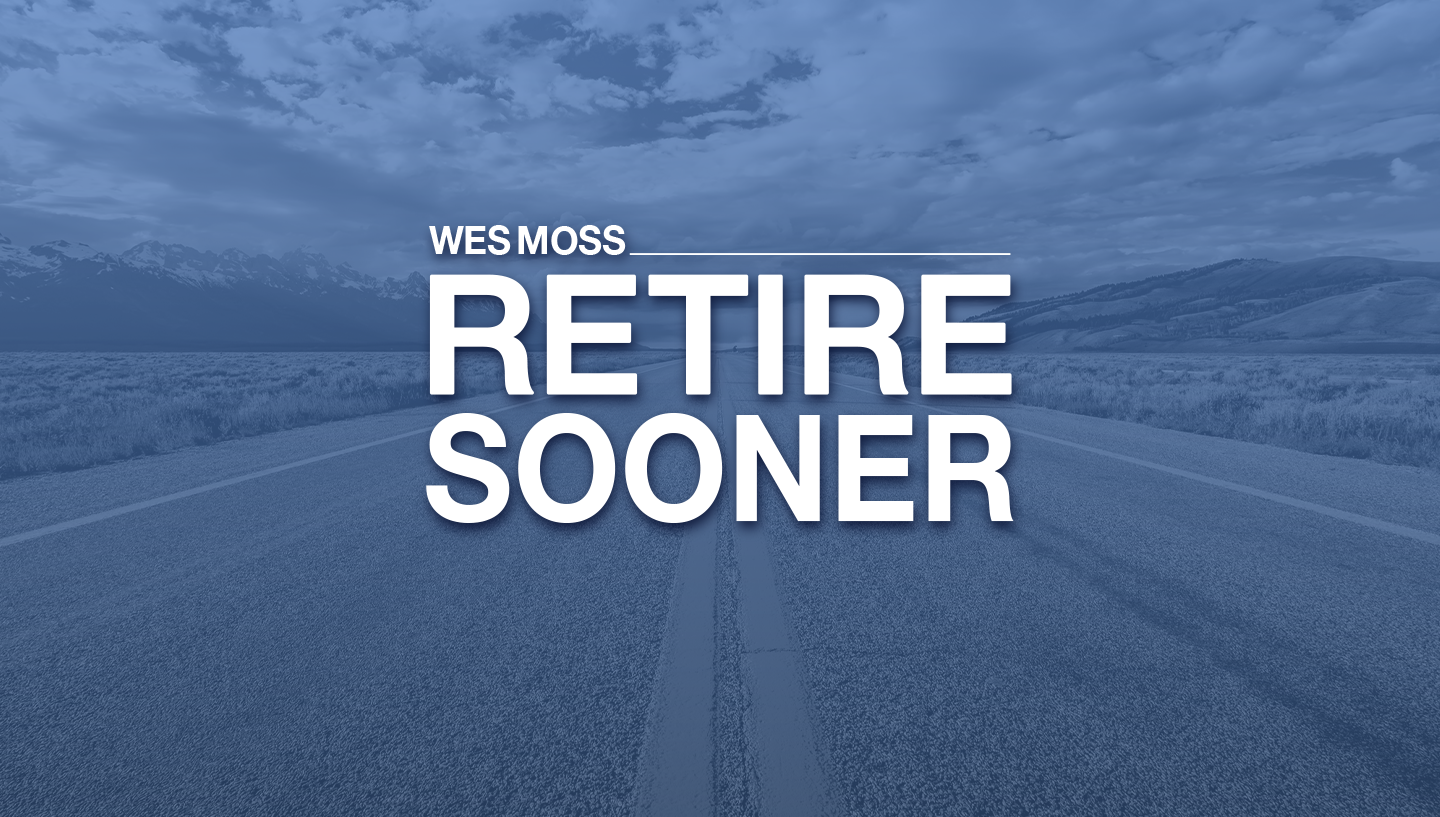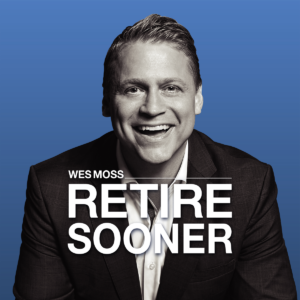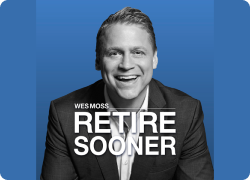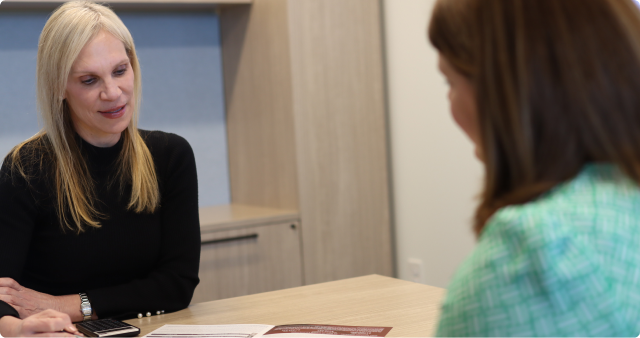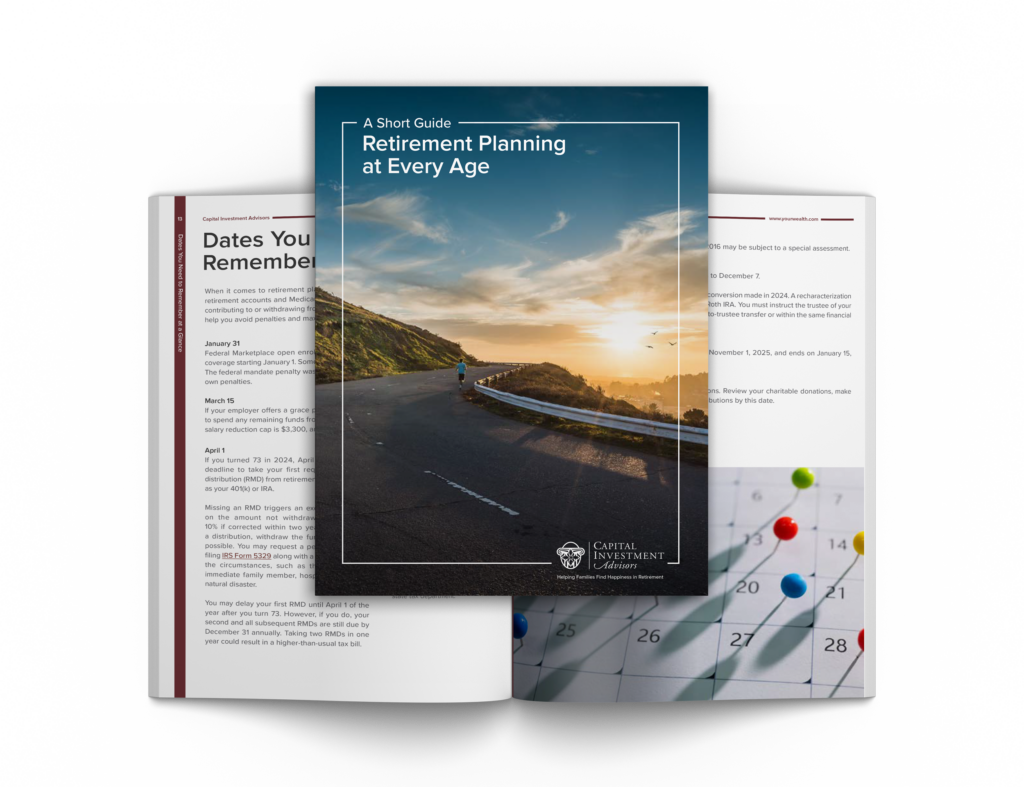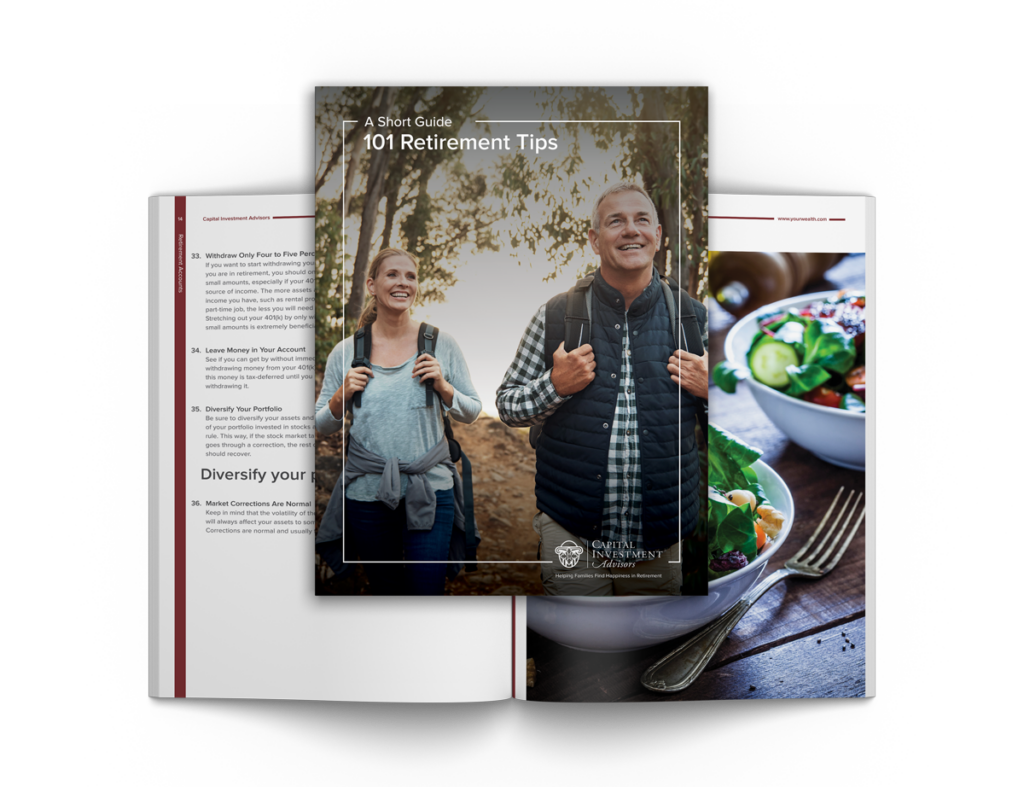Explore the latest developments in the tariff tumult, including how a lack of clarity may have led to both market meltdowns and a melt-ups: a rollercoaster of highs and lows. Learn the key takeaways from a complicated situation and discover how to potentially navigate your path to financial independence in retirement.
Headlines are temporary, but your financial plan shouldn’t be. Analyze the essential balance of diverse portfolios and dry powder. Accept that investing comes with the risk of down days, but realize the damage caused by missing the market rebounds.
Listen to Wes and Christa answer listener questions. Is it best to eradicate debt before retirement, even if that means tapping into reserve funds? Is a HELOC ever an effective strategy? Should you take Social Security early if given the opportunity, or maximize the impact by waiting?
Examine the Mappiness Project, where a team of data scientists from the London School of Economics used an iPhone application to measure happiness, anxiety, and emotions tied to geolocation. Find out what helps human beings cut through the superficial into deeper contentment, and where they tend to be when accomplishing that goal. Wes probes his interview with former Google data scientist Seth Stephens-Davidowitz to illuminate the unvarnished truth and surprising conclusions.
All this and a savvy Warren Buffett quote about haircuts on today’s episode of the Retire Sooner Podcast.
Read The Full Transcript From This Episode
(click below to expand and read the full interview)
- Wes Moss [00:00:04]:
I’m Wes Moss. The prevailing thought in America is that you’ll never have enough money and it’s almost impossible to retire early. Actually, I think the opposite is true. For more than 20 years, I’ve been researching, studying and advising American families, including those who started late, on how to retire sooner and happier. Now I’m bringing in my good friend Christa Dibias, who has worked closely with Clark Howard for many years now to answer your questions and explore what makes a happy and fulfilling retirement. My mission on the Retire Sooner podcast is to help a million people retire earlier while enjoying the adventure along the way. I’d love for you to be one of them. Let’s get started.Wes Moss [00:00:50]:
Wes Moss, your host here in studio and the great Christa DiBiase right here in studios.Christa DiBiase [00:00:57]:
Wesley, things have been very turbulent to say the least.Wes Moss [00:01:01]:
I would say that’s an almost an understatement.Christa DiBiase [00:01:03]:
And then also, I love your retirement research that you’ve done over so many years and you’ve written books about. You’re going to be talking about what really makes people happy, right?Wes Moss [00:01:13]:
Ultimate retirement happiness.Christa DiBiase [00:01:15]:
I love that.Wes Moss [00:01:15]:
Really human happiness through data science.Christa DiBiase [00:01:18]:
That’s what we really want.Wes Moss [00:01:20]:
So we, so we really have two. I guess we’ll start with talking about tariffs and really the market volatility and just the lack of clarity. I’ve had to say there’s one thing that has wreaked havoc on markets and we’ve had really bad markets very quickly and then we’ve had historically good days all, all at the same time. And really we, the last week we had a day that was the third best day for stocks since World War II.Christa DiBiase [00:01:49]:
Wow.Wes Moss [00:01:49]:
When you see a headline like that, I mean, that is. I took a screenshot of the stocks that I follow and the investments that I follow just to have it at the end of the day, just for posterity because it was really eye opening and kind of remarkable to see. But really, of course, we’ve all, unless you’re living under a rock, you know, the uncertainty that we’re going through, which is the talk around tariffs and the United States putting massive tariffs on every country around the world and every trading partner and then reciprocal tariffs on top of that with some formula that no one really understands and then pausing those tariffs for 90 days with all countries except for China and really the uncertainty around all of that. And just think about what’s happened just over the last call it month or so. It’s created this really, the roller coaster was going straight down for many days and then we had this huge roller coaster that but came back higher and there’s a lot of lessons from that. So maybe I’ll just quickly start with. I think the confusion around tariffs is. I was driving my kids to school the other day and my little guy, my third grader, he goes, who are these tariffs that we’re at war with? He goes, are the tariffs people? And I said, no, they’re not people, but they’re basically taxes on goods coming from other countries.Wes Moss [00:03:13]:
Because the, this negotiation that we’re in, good, bad or indifferent, regardless of whether you believe it’s good or bad, they are taxes on goods coming in and it makes things more expensive. Now, it depends on who eats that. Does the producer overseas eat it or all of it or part of it? Or do we eat it as consumers? And I know that. I think the reason my little guy was thinking is these are people. Because you keep hearing about trade war. It’s like you got to go to war with people, right? And really the way I look at this is, and what I tried to explain, like these are not people tariffs, but they do impact people and they affect people. And this is, you could call it a trade war, you could call this a global trade renegotiation. And that’s really what I’ve been thinking about this for the last month.Wes Moss [00:04:02]:
And then it’s really hard to argue that it is not a big negotiation now that you’ve seen this pause. And then the European Union paused and so we’re really very much in this negotiation. And then last night we were at the dinner table and it was my, one of my high schoolers said something about tariffs and said, yeah, I don’t really even understand these tariffs. And my third grader chimed in, he goes, look, first of all, tariffs are not people. They’re not people. They’re basically a tax on goods coming in from other countries to try to make us buy more stuff within the country as opposed to. So proud of that little guy.Christa DiBiase [00:04:37]:
Awesome.Wes Moss [00:04:38]:
And so maybe wondering about my high schooler who didn’t understand it, but anyway.Christa DiBiase [00:04:45]:
Hey, he can get in line. I mean a lot of people don’t. It’s confusing.Wes Moss [00:04:48]:
It’s a lot to understand because it is a fluid, it’s not a black and white. And then you start hearing about non tariff barriers. That’s a huge part of this, which are currency manipulations that countries do to make their change the price of their goods. So it’s very complicated. So all of this created this meltdown and then a pause, created a melt up. And that’s the best way I can describe it. I mean, almost 3,000 points higher in one day for the Dow Jones industrial average, up 12% for the NASDAQ. I mean, these are, again, historically incredible moves.Wes Moss [00:05:23]:
And that’s where we stand. And I don’t think that any of this goes away anytime too soon. Sure, we have this pause, but that means we’re still in negotiation. So we’re going to be in this period as investors of not as much uncertainty as we’ve had leading up to this, but the uncertainty will continue. And they’re always clouds when it comes to investing in markets. But we’re in a period of time where it’s going to be cloudy for a little while. It’s not as rough. And the clouds, I’d say, are less dark for investors than they were prior to this pause that we’re in.Wes Moss [00:05:54]:
But what do you do for that? And I think I go back to the very same point that I’ve tried to make here and on, on other radio and podcasts that I do, is that we’ve got to stay balanced. And when you’re balanced and you have a portion of your investments towards the equity markets or stock markets and you have a portion in safety, when things are going really well and the stock market is going through the roof, you tend to get almost disappointed in that because you, you’re not participating in the, in the upswing with everything, right? If you only have 60% in equities, then as the markets are going higher, you think, wait, maybe I should have 70, maybe I should have 80. So we’re always, as investors, pulled towards maybe it should be doing more and more of what’s working. And then you go through a period of time when the markets crater by 12% in just a couple of days. And that’s how bad this was and how quickly this was very much reminded me of and still reminds me of that Covid period of time where markets cratered and then they snap back and they cratered and snap back. And this is where you’re so happy. And so I think feeling at least calmer about this when you do have balance. And it’s just so important when I go through these periods of time, I’m very thankful for the balance that I have, and you could argue that I should be 100% in stocks, but I’m not, because I do like having a balance, even at my age, particularly for retirees who absolutely, in my opinion, need a balance and stay diversified and stay balanced.Christa DiBiase [00:07:21]:
And you’ve been talking for months about dry powder.Wes Moss [00:07:24]:
Dry powders come in such handy here, which is just a couple years worth of spending money in safety assets, money markets, high quality bonds. Then lastly, I would say headlines are temporary. They feel permanent when you’re living through them and they feel unending. But when is it? How can this end? I mean, we’re going to go back and forth forever and who knows what these 10 countries do in these 10 countries and do they band together and does do we go into recession? The headlines are always temporary and they feel almost like they’re not going to go away, but they’re temporary. And your financial planning and your investing has to be permanent. It can’t be temporary. It can’t just be. I’m going to change plans just because the headlines are bad today.Wes Moss [00:08:12]:
And what an amazing reminder the last month has been for that. Because in another market statistic or market history that is so important to understand. Almost every really good day we’ve ever had in markets is right around and near the really bad days. And we saw that just play out exactly like we’ve seen it during history. A horrible couple down days. World of people are getting extraordinarily nervous. I get message from my mom. Sell, please sell.Wes Moss [00:08:40]:
Seriously, I think we need to sell a day or two later. Markets are through the roof and we know the statistics. When you look this up, you’ll see missing the best days versus the worst days. I think of it as missing the rebound. Missing the rebound days. If you go back almost any period of time, this data works out this way. But if you go back over the last 25 years, markets have averaged. If you’re fully invested and you’ve done the whole roller coaster over 10% per year on average, you miss 10 days out of 20 years.Wes Moss [00:09:13]:
So think every other year you miss the best day, 10 days out of 20 years of investing, that drops, your rate of return drops by 40%. So you go from over 10% to around 6%. And the reason I think that we talk about this and look at history, the rebounds come when you don’t expect them. The rebounds come when the clouds are usually the darkest. If you sell out and then you miss the rebound and then you really miss out being an investor. And the way I look at this, and even this month has given me even further perspective on this, if you can’t sit through these and stick to a plan that’s more permanent versus temporary headlines, then you almost shouldn’t be an investor, period. It’s almost not worth it because you miss a little Bit of the good and it wipes out the rest of your gains. If you can’t handle that, it’s almost better psychologically.Wes Moss [00:10:06]:
And from a risk tolerance perspective, it may be better just to be in safety assets, but that also makes things really hard to just be a saver versus an investor. So uncertainty is part of the game. I don’t think it’s going away anytime soon, but balances our friend. Patience is our friend.Christa DiBiase [00:10:23]:
Thanks, Wes. Okay, we’ll go to questions that came in for you. This one’s from Rick in North Carolina. I’m not sure if I’ve missed this, but I always hear you guys talk about how much someone should have to retire comfortably. If the number is $700,000, are you talking about a household or an individual? If it’s an individual, does that mean a household would need $1.4 million or something less? Might be a good point to make as you’re discussing this topic. Great show. Keep up the good work.Wes Moss [00:10:52]:
Rick sounds like a great guy. He’s from the Tar Heel State, so I’m hoping that he’s a Tar Heel and he’s not Duke. I would say this to Rick. This is a good question because when we talk about liquid retirement assets for happy retirees, the median number we have seen work and these are inflation adjusted numbers. I’ve done a lot of research over the years and there is no perfect number obviously. But these numbers I see really do work in practical terms as well. And I see folks move into the happy camp versus the unhappy camp once we reach these numbers. And the median number, it’s kind of the middle of the Data set is 750,000 and the average is about a million and a quarter.Wes Moss [00:11:34]:
And that is to answer your question very simply, it’s for the household. It is for the household. And now you’ll naturally going to say, well, wait a minute, well, if it’s just me, do I still need those same numbers? And the answer is yes. And if you’re wondering or asking, well, that sounds like it’s a lot harder to get to 750 or a million a quarter if it’s just me. And it’s because that’s true, it is harder. And if you think about when you do, if you’re at dinner and you’re splitting the check, it’s a lot easier on your wallet. It’s the same thing in retirement. If you’re splitting the check for retirement, you’ve got Social Security.Wes Moss [00:12:11]:
Your spouse or partner has Social Security. Those are two big income streams that Happen together. You’re saving. Your spouse is saving for 20, 30 years. I mean, it’s really helpful to have somebody else to do this with. It doesn’t cost a lot less if it’s just you. Now, of course, it’s a little bit less, but the mortgage is still the same. The utilities are still the same, a lot of the costs are still the same.Wes Moss [00:12:36]:
And that’s why it is easier if you’ve got somebody to split retirement with and help with retirement. But bottom line, this is a household number. Yes, you can make an argument it can be a little bit less if you’re single. But those are the research statistics that I’ve done is that those numbers are per household.Christa DiBiase [00:12:52]:
Thank you. Okay. Catherine in California says, my spouse and I are looking for the best way to utilize our money.Wes Moss [00:12:59]:
See, Catherine’s splitting it. She’s splitting the cost of retirement.Christa DiBiase [00:13:02]:
We are debt free except for the mortgage. We have $500,000 in retirement accounts and 400,000 in savings. We would like to do some home remodeling. Would you recommend a HELOC or just paying cash for that? And also, if we’re looking to invest the balance of savings, would a taxable brokerage account be the best option?Wes Moss [00:13:22]:
So, Catherine in California, my thought here is that it depends on the cost of the renovation. And they have 400. So 500,000 retirement accounts and 400,000 in after tax money first out of the gate. I would just say there’s a little bit of. If I had to rank which is a more important account or more helpful, what has a higher utility value, it’s going to be the taxable account. Now, the taxable account, even at these numbers, I’d still say it’s taxable account because it’s after tax money. You can control your tax bracket with a taxable account. If you’re looking at dividends, those are usually much lower taxes than ordinary income.Wes Moss [00:13:58]:
You pull money out of a retirement account, it’s ordinary income, which usually are higher. Those are at higher rates. So the utility level, I’d say it’s a retirement account, super useful. But a taxable account of retirement is even more useful. And then, of course, above that even is the Roth account. But it takes a lot of work to get it. There’s. If the renovation, Catherine, is $50,000, then I’d say probably just pay for it out of the cash, even up to $100,000.Wes Moss [00:14:28]:
I would say pay for it because I like to use the rule of thumb. You first. Are you. You really don’t want to have debt going into retirement. So you do want to have either your mortgage paid off, you don’t really want to he lock. And I would say that my rule of thumb is if you can use a quarter or less of your taxable money, go ahead and pay for it. So if it’s 100 for the renovation, 400,000, it’s a quarter of it. So if it’s more than a quarter, then I would say you don’t want to get rid of that much of your after tax money just to have no debt, which they’re both things.Wes Moss [00:15:05]:
We want a high balance in after tax, but we also want no debt. And if this is a $200,000 renovation, I think it’s probably almost too much to drain that taxable account. So then you would. I would say sure, go ahead and use a heloc. Even though rates are pretty high, you still want to keep the sacred bucket of money that’s after tax.Christa DiBiase [00:15:26]:
Great. This came in from Cliff in Idaho. My wife and I have done well with our investments through our 401ks. We have a mix of Roth and traditional 401ks, a healthy HSA account, and are starting a long term S and P for purchases.Wes Moss [00:15:42]:
Probably S&P 500. Yeah. Okay.Christa DiBiase [00:15:44]:
I’m 55 and plan to retire in 10 years. My wife is still working for a couple of more years. When’s a good time? Time to start interviewing financial advisors. We should be set for retirement once I’m 65 with plenty set aside. We like to plan ahead to make sure we have a good strategy well ahead of retirement. My wife is already at the age where she can withdraw without penalty from a retirement account. Is there an advantage to putting our S and P into a Roth under her name for long term spending, for things like a car, remodeling, etc. Would we be able to withdraw the gains tax free versus putting the money in a regular non retirement S&P 500 fund where we’d pay 15% on the gains after a year.Wes Moss [00:16:26]:
So he’s asking when’s it a good time to have a financial advisor? That’s kind of the beginning of the question. This is Cliff, right? Cliff. I would just say the. I mean, you’re asking a financial advisor if it’s a good idea to have a financial advisor. What does Warren Buffett say if you ask a barber if you need a haircut? He’s always going to say you need a haircut. So a couple of things. One, I would say if you’re doing a lot of this planning and you’re comfortable investing and you understand your risk tolerance, you understand the balance and the fundamentals of investing, then you may not need a financial advisor. Not everybody needs a financial advisor.Wes Moss [00:16:59]:
Some people like to do financial planning on their own. They like to do their investing on their own. So you don’t necessarily need a financial advisor. However, I’ve been a financial advisor and then fiduciary for the last 15 some years, certified financial planner over my the course of my career and I still like to bounce things off of my team when it comes to whether I’m helping a family. It’s nice to get a couple of inputs to make sure you’re getting things right. For my own planning, I have advisors that particularly within estate and within tax and I like to talk to my CFP friends on, on investment strategies as well. So I’m a believer in having that help because it’s kind of an important thing. Right.Wes Moss [00:17:43]:
Your health would probably be number one. Health relationships, people. And then I don’t know what else is more important to get right or not mess up the financial planning side and the retirement side. So if you’re already thinking about all this, unless you really like doing this on your own and you’re comfortable, then I don’t think it’s ever a bad time to start consulting someone that can give you objective financial advice. Right. Obviously, beyond what we’re talking about here, talking about the nitty gritty of your situation, the next thought would be around the Roth. You had asked a question about a Roth. Again, that’s the highest value account you can get money into.Wes Moss [00:18:20]:
Regular retirement account, taxable account, then the highest on the utility scales, the Roth. So getting money in there is super important and helpful. It’s just about when you can do that and the timing on your tax bracket. Now, if you’re not looking to convert it millions of dollars into a Roth, then it might be pretty easy to do. So if you’re in a lower tax year, you’ve got standard deduction and again you need to consult a CPA when it comes to what it’s going to cost because the conversion will be taxable and you’ve got to pay the taxes in order to do that. To have money in a Roth to pay for housing and cars in the future is great. The other caveat there is that when you’re converting Cliff into a Roth, remember you got to leave those conversions in there for five years. So you can’t just convert and then use immediately.Wes Moss [00:19:06]:
So you’ve got that five year window. You’ve got to be cognizant of that as well. But a, it sounds like it’s probably, there’s not a lot of downside to have a financial advisor if you’re finding the right person. One and two, be careful on when you’re doing the conversion. But I like the idea of that Roth conversion a lot.Christa DiBiase [00:19:24]:
Great. And I just want to say from my own perspective that I don’t like to handle this stuff myself. I do use a fiduciary and I think it’s worth maybe interviewing a couple fiduciaries if you’re unsure. They’d probably be willing to talk to you if you’re kind of on the fence. And to me, it’s more about, and.Wes Moss [00:19:39]:
I would say you know more about this stuff than 95, 99% of people.Christa DiBiase [00:19:43]:
Yeah. But I just, I don’t want to, I don’t want to handle it myself. And I also feel like it’s more about planning and looking at, you know, streams of income, like just getting a bigger picture about retirement. And speaking of that bigger picture, you’ve done so much research on what makes us happy in retirement and I know you’ve got some data you’re going to share with us straight ahead.Wes Moss [00:20:05]:
Right. We’re talking about ultimate retirement happiness.Christa DiBiase [00:20:07]:
Yes, that’s the goal. We’ll be right back.Wes Moss [00:20:12]:
Are you facing a fork in the road and deciding between continuing your career and retirement? I’m Wes Moss, host of Money Matters. And this massive life decision shouldn’t be taken lightly. Talk with my team if you’d like help reviewing your retirement accounts and building a financial plan. We can help you review options and offer an opinion based on your best interests. You can find us@yourwealth.com that’s y o u r wealth.com. krista, we talked before the break. We were going to go into some of the data behind what makes people happy, humans, what makes humans happy, and of course, what makes retirees happy. And there’s a really big dichotomy on this list I was able to interview.Wes Moss [00:20:58]:
Just one of the more memorable and fascinating interviews I’ve ever had was with a data scientist named Seth Stephen Davidowitz. And I think he was many years at Google and he started analyzing anonymous search data, meaning that instead of asking people what they thought in surveys, he wanted to understand what people were searching when no one was looking. So again, it’s a little creepy to think about this, but he wasn’t looking at person A and what they searched, just the big Aggregate. What are people searching for? Knowing that. That they’re really interested in it or they’re really scared of it. So he kind of just reverse and engineered what makes people happy and what makes people somewhat miserable. We also talked about a project. So again, this is data.Wes Moss [00:21:48]:
This is not people answering surveys, research. We also talked about a study called the Mappiness Project. Have you ever even heard of that?Christa DiBiase [00:21:56]:
I don’t call that. No.Wes Moss [00:21:59]:
So just take the word happiness and map and put them together. And this was a team of, again, data scientists out of London School of Economics that over a long period of time, had an application on an iPhone and they were able to measure people’s level of happiness, anxiety, really emotions, and know exactly where they were. So if they were in the woods, then the reported emotion comes through that this subject was in the woods, or this subject was at a soccer game or a football game in Europe, or they were driving in the road, or they were likely at work because they were sitting in the city or they were near a body of water. And that Mappiness project, really, it ranked kind of 40 of the main things we do in the world, and it also mapped the locations of where humans are happy or unhappy. And it comes back, the great news here is that this list of ultimate human happiness, and we’re talking about happiness here, not an Instagram ad for some beautiful place. We’re talking about what wakes you. It’s kind of deep. Oh, I feel great about this.Wes Moss [00:23:10]:
I’m smiling from the inside. This is not a superficial. I think it cuts through the superficial happiness, but. But deep human happiness. And what they found was that people are happiest when they are one in warm weather. Warm weather, actually, 80 degrees was kind of the ultimate. I would choose like 75.Christa DiBiase [00:23:33]:
I’m great with 80. Check.Wes Moss [00:23:34]:
80 degrees being near the water.Christa DiBiase [00:23:37]:
Oh, check.Wes Moss [00:23:38]:
Something about that creates deep human happiness and contentment and spending time with someone you love. That’s it.Christa DiBiase [00:23:47]:
That makes complete sense.Wes Moss [00:23:48]:
And again, none of that’s probably shocking, but these are all fundamental human things that give us the sense of joy and peace. So here’s the list of the top five, number one, intimacy, either physically or emotionally, from the Mappiness Project. Attending the arts, concerts, theater. I don’t know why that’s on there, but it kind of makes sense. When was the last time you’ve been to a concert and you weren’t in a good mood?Christa DiBiase [00:24:15]:
Oh, totally.Wes Moss [00:24:16]:
Visiting art exhibitions, museums. Number four. Exercising, sports, physical activity, number four. So again, out of 40, so high on the list, and number five on the list, gardening and spending time in nature. Again, think back last time you’re in nature. It’s kind of hard to be in a bad mood, right? And something fundamentally about that is important to us as humans. And it brings us a deep sense of joy. Number now the bottom of the list, which is kind of interesting at number 36, housework.Wes Moss [00:24:50]:
30, even worse is commuting. Number 38 is administration and chores. Now I would, I would push back on that. Some chores I love. I used to love to mow the lawn. I don’t love it anymore. I love to vacuum. Oh, I get this.Wes Moss [00:25:05]:
I don’t know.Christa DiBiase [00:25:06]:
It’s a. I like vacuum satisfying. It’s like immediate emptying out the thing. And I just. No, but I’m like so satisfied that that’s not on my floors anymore.Wes Moss [00:25:15]:
As you can maybe. But 40, this is not a shocker either. Worst thing as a human is to being sick in bed.Christa DiBiase [00:25:21]:
Yes. Oh, yeah.Wes Moss [00:25:22]:
But just one spot above that. Number 39 on the list. So this is way, way, way down for humanity does not bring us happiness. Work, working, AKA your job.Christa DiBiase [00:25:34]:
Wow, that’s not true for me.Wes Moss [00:25:36]:
I know goodness.Christa DiBiase [00:25:37]:
I’m very fortunate. I know this is.Wes Moss [00:25:39]:
On average, humans just don’t love, you know, being at work. So now the reality. So you’ve got this juxtaposition we know in order to do so. First of all, none of this is super expensive. When we think about what it takes to be in retirement, those numbers are gonna be different for everybody. I do find this plateauing effect at a certain point, you hit the right number for you planning wise and more doesn’t necessarily bring higher levels of happiness. I think of this as diminishing marginal returns per new dollar past a pass of happiness past a certain point. So on average, again, what I found is getting to about a million and a quarter for a household usually does the trick because million and a quarter in the 4% rules, 50,000 a year, two folks getting Social Security usually around 50 a year.Wes Moss [00:26:28]:
That’s $100,000 a year. And if you have no mortgage, well, that’s a lot of money to be able to do what you want to do. Certainly what’s on the top of the list for humanity, which is warmer weather near the with someone you love. Doesn’t cost a fortune to do that. However, we’ve got to be able to work. And we can do. The good news is we can do all this before we retire. Right? And we as we’re working, we can focus in on These things and the importance of them while we’re still in our working years.Wes Moss [00:26:58]:
You don’t have to wait until retirement, but in order to be able to stop working, as much as most people don’t love it, work is what gets us to the point where we don’t have to work. So that’s the dichotomy. Right. And we all know that as well. So we’ve got to be able to use our work to be able to save and invest to get to the point where we no longer have to work and we can still be by the water 80 degrees with someone we love.Christa DiBiase [00:27:20]:
That sound.Wes Moss [00:27:21]:
Maybe throw in a concert here or there.Christa DiBiase [00:27:22]:
Sure.Wes Moss [00:27:23]:
But that’s just fundamental human happiness and it applies directly to retirement. And I love thinking about this from a data perspective. One of the top misery so beware of social media. And Seth Steven Davidovitz shows that the more time we spend on social media usually leads to negative emotions. One thing that’s really low on the list or high on the misery list is playing games on your phone. I know, I see kids do that all the time. But you get on an airplane, it’s not uncommon to see 10 adults playing some sort of game on the phones. That does not bring happiness whatsoever.Wes Moss [00:28:02]:
So we stick with what works. We’ll avoid doom scrolling in the Internet and social media and we’ll let data lead the way to retirement happiness.Christa DiBiase [00:28:12]:
I feel like the wordle does bring me happiness every day when I do that. But there is a great book about this called the Anxious Generation, which has a lot of additional data you might be interested in about. Yeah, what social media has done and being online to. Especially to kids. Okay, we’ll go to questions. Craig in Utah says, I’m familiar with the 4% rule of investing where each year if you withdraw no more than 4% of the money invested, you’ll likely never run out of principal. But where is a good place to invest your money so you can do that?Wes Moss [00:28:42]:
Where the. So this is Craig question. Yeah, yeah. I think a couple of things. One, remember, it’s not just the four. I think this is why we probably talk about this a lot because there’s a lot of different pieces to this rule and it constantly. I remember when I started writing about this 15 years ago, I remember I did a spot check and asked a bunch of financial advisors what the 4% rule was. And I got 10, you know, asked 10 people.Wes Moss [00:29:09]:
I got five different answers because a lot of folks make that the 4% rule is supposed to be 4% of your money when you start and then it’s that number in a dollar amount ratcheted up for inflation for the rest of retirement. So it’s not just 4%, it’s 4% to start. Then it’s 4% of the original balance plus inflation. Now, the other critical part of that rule is that where it needs to be invested in historically to get these numbers to work to be able to increase your income for inflation. The rule of thumb, there is at least 50% in broadly diversified equities, up to 75% in diversified equities. Now, beyond that, it can work out really well, but there’s also a higher level of failure, AKA running out of money when you have too much in stock because you can go through periods of time that are really difficult, particularly in the early years. And this is called sequence of risk. If you have early years where the markets are going down and you’re pulling from your assets, that can unwind and make the rule not work as well.Wes Moss [00:30:15]:
So where 50 to call it 75% in diversified equities, those can be index funds. United States Prime. These studies are done primarily for large cap stocks, Christa. So that wouldn’t apply if you had a bunch of small and micro cap stocks. So it’s really large cap stocks with a small amount of mid and small cap is appropriate in that mix. So let’s call it 10% of the 60. So 50 large, 10% small, and then the other 40% in what we would consider dry powder or just safety assets. And it can be done in any account.Wes Moss [00:30:50]:
It doesn’t have to be in a particular account, whether it’s 401K, IRA, taxable account, Roth account. It’s really making sure you have that balance among all of those accounts collectively. And that’s one of the fundamental drivers of making the 4% rule. I called the 4% plus rule work.Christa DiBiase [00:31:08]:
Great. Rochelle in California says, my husband and I are planning to pay off our home this summer and I’m reaching out for some advice. We live in California where we can continue to work. My husband’s 61 and I’m 55. Our children are grown and independent and we are fortunate that they are productive adults. We both have CalPERS retirement funds as well as 403Bs and Roth IRAs. Our combined income is 240,000 and our home is currently valued at just under 900,000. With our home nearly paid off, we’re considering purchasing another property.Christa DiBiase [00:31:41]:
We’re interested in exploring whether this could generate investment income and offer potential tax benefits. However, I’M hesitant to buy a home. Given the home prices in California are still quite high, do you think this would be a wise move for us? Additionally, if purchasing another home is a good idea, would it be better to pay off our current home first or should we consider borrowing against it before for doing so?Wes Moss [00:32:03]:
Whoa. So this is real estate. Rochelle is hyper local. So I don’t know. Again, I have family in California. They’ve lived in a couple different towns, cities. I’ve got plenty of families I’ve worked with over the years. So I know California, but it’s giant.Wes Moss [00:32:21]:
It’s like the size of a country. So the real estate there of course is hyperlocal. Couple of thoughts here. One, when it comes to, and I love real estate for extra income, it’s, it is absolutely a source, right? We’ve got Social Security, pension, investment income, dividends, veteran benefits, hobby income, part time work, and rent. So I love the idea of getting some rent. The, the rule of thumb around that though Rochelle is the is. And I know California real estate’s really expensive, has everything to do with the cap rate, which is the capitalization of real estate is simply money coming in. So your net, your net operating income coming in divided by the price of what you’ve got to pay for the property.Wes Moss [00:33:08]:
So yes, California real estate is expensive, but so are rents high. So if you have a property and you’re bringing in ten grand in net operating income, the property is half a million dollars. That’s a 2% cap rate, which is no good. You don’t want, you wouldn’t want all that work and all that risk for such a low cap rate. If it’s 50,000 coming in in rents at net rent, after all the things you have to do to keep the property up, that’s a 10%, $500,000 property. Now you’re talking about a 10%, that might be a really good investment. Kind of the minimum floor for most real estate investors is 5%. So a net amount.Wes Moss [00:33:47]:
What’s the math on that, Christa? You would need 25,000 or so. So 500,000 times 5%, 25,000 in net income coming in for the property. Now of course you’ve got appreciation, but that’s not a guarantee. Right? Because you’ve got, of course California real estate seems to just keep going up and up and up, but not in every single area.Christa DiBiase [00:34:08]:
Right.Wes Moss [00:34:08]:
We’ve got lots of natural disasters that happen. I don’t know the town you’re in, but there’s some real risk in the state too. So I would just say if you’re looking for real estate, looking for the cap rate of 5% or higher, basically good rent for what you pay for it, number one. Number two, be aware of the work that it takes. It’s not a, it’s not just a flip a switch. Real estate is work. And three, do you take out a HELOC to do it? I think that really depends. I like to be in retirement with very little to no debt debt.Wes Moss [00:34:40]:
I know that that raises levels of peace of mind and happiness, but it’s also not totally out of the question. If you find an amazing property that you know will work, real estate investors will look at 20, 30, 50 properties before they buy one. If you really know your property and you believe in it, it may be okay to have some come from a heloc, have your house paid off. Except for that if you do run into trouble, hopefully you can sell the other property. There’s a lot to unpack there. But I would prefer if you didn’t have to do a ton of debt and be leveraged heading into retirement.Christa DiBiase [00:35:16]:
I would also say make sure you check what the insurance cost would be on any property that you might buy because it’s gone up by so much and I don’t know if you plan on using it for a rental if that makes it even higher. I’m not sure how that works, but I know particularly in California, it’s gotten incredibly expensive. Okay. Ruth in Massachusetts says I’m able to collect Social Security for my deceased ex husband at age 60. I’m currently 59 and was wondering if I should take it at 60 because that gives me two extra years compared to most people who collect at 62. I don’t need the money right now, but it seems certain that Social Security will get cut in the future. So does it make sense to take it?Wes Moss [00:35:55]:
Ruth? Okay, there are a lot of rules around this and I would say that you’re going to probably want to meet with Social Security. This is a great because there’s a lot to this. But Ruth is saying she is qualifies, right? So yes, you can go ahead and take it at 60 and the in the as a these that’s a spousal benefit in her situation even though her husband is deceased and ex husband is deceased. And there’s some rules around that. I want to say the ten year rule there. But Ruth, you can start taking it now and yes, you can eventually switch over to your own Social Security if it’s higher. Now there’s also some just like any other Social Security decision, just because you can take the spousal benefit as early as 60, which is two years before 62, the longer you wait, it does go up. So she’d be taking the minimum amount if she started it that early.Wes Moss [00:36:50]:
So that’s one consideration. Maybe you want to wait even a little bit for when you start that. But in the background, this is how I think about this. Your own benefit will continue to go higher and in a lot of ways, particularly if she’s been working by the time she gets to 70, let’s say her spousal benefit is 1,600 and she kind of starts that at 60, and that gets pretty much locked in. There’s a little bit of inflation by the time you get to 70. If your own social is 2,500amonth, then you can switch to that. But there’s a lot of moving parts there. I would just say every time I answer Social Security question, there’s 10 people saying, but, but, but.Wes Moss [00:37:31]:
And if you miss it, the reality is you get to sit down with Social Security, know the exact numbers, confirm all this with them. But yes, you should be able to wait on your own and turn it on in the future if it’s higher. Great, Chris, I love having you here. I love these questions. So thank you as always, for being in studio. Send us more questions@yourwealth.com contact. Have a wonderful rest of your day.Mallory [00:37:59]:
Hey, y’all, this is Mallory with the Retire Sooner team. Please be sure to rate and subscribe to this podcast and share it with a friend. If you have any questions, you can find us@wesmoss.com that’s W-E-S-M-O-S-S.com youm can also follow us on Instagram and YouTube. You’ll find us under the handle Retire Sooner podcast. And now for our show’s disclosure. This is provided as a resource for informational purposes and is not to be viewed as investment advice or recommendations. This information is being presented without consideration of the investment objectives, risk tolerance or financial circumstances of any specific investor and might not be suitable for all investors. The mention of any company is provided to you for informational purposes and as an example only and is not to be considered investment advice or recommendation or an endorsement of any particular company.Mallory [00:38:46]:
Past performance is not indicative of future results. Investing involves risk, including possible loss of principal. There is no guarantee offered that investment return, yield or performance will be achieved. The information provided is strictly an opinion and for informational purposes only, and it is not known whether the strategies will be successful. There are many aspects and criteria that must be examined and considered before investing. This information is not intended to and should not form a primary basis for any investment decision that you may make. Always consult your own legal tax or investment advisor before making any investment tax, estate or financial planning considerations or decisions. Investment decisions should not be made solely based on information contained herein.
Call in with your financial questions for our team to answer: 800-805-6301
Join other happy retirees on our Retire Sooner Facebook Group: https://www.facebook.com/groups/retiresoonerpodcast
This information is provided to you as a resource for educational purposes and as an example only and is not to be considered investment advice or recommendation or an endorsement of any particular security. Investing involves risk, including the possible loss of principal. There is no guarantee offered that investment return, yield, or performance will be achieved. There will be periods of performance fluctuations, including periods of negative returns and periods where dividends will not be paid. Past performance is not indicative of future results when considering any investment vehicle. The mention of any specific security should not be inferred as having been successful or responsible for any investor achieving their investment goals. Additionally, the mention of any specific security is not to infer investment success of the security or of any portfolio. A reader may request a list of all recommendations made by Capital Investment Advisors within the immediately preceding period of one year upon written request to Capital Investment Advisors. It is not known whether any investor holding the mentioned securities have achieved their investment goals or experienced appreciation of their portfolio. This information is being presented without consideration of the investment objectives, risk tolerance, or financial circumstances of any specific investor and might not be suitable for all investors. This information is not intended to, and should not, form a primary basis for any investment decision that you may make. Always consult your own legal, tax, or investment advisor before making any investment/tax/estate/financial planning considerations or decisions.

